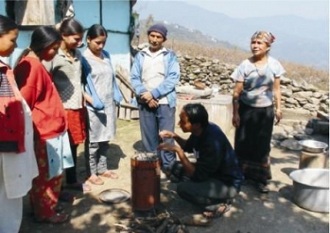International Journal of COPD 2012:7 253–257
Epidemiology of chronic obstructive pulmonary disease: a descriptive study in the mid-western region of Nepal
Ramjee Bhandari
In Nepal, COPD accounts for 43% of the noncommunicable disease burden, and 2.56% of hospitalizations. Though tobacco smoking is established as the primary cause of COPD, indoor air pollution from biomass and/or traditional fuels is estimated to be associated with 0.4 million deaths from acute symptoms of COPD.
Studies have shown that smokers in Nepal have a 70% greater chance of developing COPD. In Nepal, more than 85% of households (98% in rural areas) still rely on biomass fuel. Nepalese women are at higher risk of developing COPD through exposure to indoor air pollution; additionally, about 15% of women also smoke tobacco.
Journal of the Indian Institute of Science, March 2012.
India: Development and Dissemination of Fuel-Efficient Biomass Burning Devices.
S.S. Lokras
Applying the principles of combustion and heat transfer, we have developed fuel-efficient, wood and other biomass burning stoves, furnaces and driers for a variety of operations carried out both in rural and urban areas. This paper highlights the concepts utilised for these and then summarises how the concepts have been used for developing the various devices. The dissemination strategy applied, the extent of dissemination, and the benefits accrued have been detailed.
Cookstoves in Tanzania: User Insights and Opportunities, 2012.
IDEO.org
We used a human-centered design approach to examine the habits, motivations, and aspirations of cookstove users in Tanzania. We developed a consumer-based understanding of cookstove adoption and actionable opportunity areas for Global Alliance for Clean Cookstoves and its stakeholders to explore. Although focused on the Tanzanian market, many of the insights and opportunities are relevant globally.
People understand the value of efficient cookstoves when they buy them, but when it comes to each individual day, the benefits are too small to matter. What does matters every day is how arduous it is to cook a meal. Women will always default to the easier choice,making them value things that help make cooking easier and faster.
People understand the health impacts of open fires, but future health concerns don’t outweigh present economic realities.
ISO International Workshop on Clean and Efficient Cookstoves
An International Standards Organization (ISO) International Workshop Agreement (IWA) was finalized and unanimously affirmed by more than 90 stakeholders present at the ISO International Workshop on Cookstoves February 28 – 29, 2012 in The Hague, Netherlands.
The IWA provides guidance for rating cook stoves on four key performance indicators: fuel use/efficiency, total emissions, indoor emissions, and safety. A draft of the IWA is posted as the last attachment below.
Source – HEDON, March 23, 2012
We were delighted and honoured to welcome Kirk Smith to the HEDON Rig meeting last week, and to hear about many of the initiatives in which he is involved. This visit was particularly special in a week when Kirk was awarded the Tyler Prize for Environmental Achievement for services to Household Air Pollution reduction. This not only recognises Kirks important and tireless services in this field, but also indicates how smoke is moving up the public awareness agenda. These are some of the key topics which he covered. 
The new Comparative Risk Assessment coming out later this year will show mortality of around 4 million people with the increase since the previous CRA (1.6 million) being mainly adults that we know are affected by heart disease and stroke. The importance is that it shows that smoke is a major risk factor not only for acute outcomes like TB, low birth weight, and child pneumonia, but for important chronic diseases in adults.
Part of this new evidence is based on what Kirk calls Generalized Exposure Response or GER curves. These directly link the health impacts of the four major categories of exposure to combustion particles in the world:
- Smoking
- Household air pollution (HAP) from cookfires (a three-stone fire puts out the equivalent of about 1000 cigarettes per hour)
- Passive smoking (from other people’s cigarettes)
- Outdoor air pollution.
The worst thing to do is to put burning stuff in your mouth, but it is not so great either to have a lot burning poorly around your house. Someone else putting burning biomass (tobacco) in their mouth is also bad for your health, but even having combustion particles emitted outdoors is damaging. The amount of ill-health created, of course, goes down with the dose, being greatest for smoking and least for outdoor air pollution. HAP is intermediate in the level of exposure but high in the number of people affected. Also, babies do not smoke, but are affected by the other three categories, including HAP.
Surprisingly, although the dose rate is a 1000x greater for smoking than typical outdoor pollution levels, there is a smooth consistent relationship of dose to health impact running from one end to the other with HAP in between for at least five disease types: COPD, heart disease, stroke, lung cancer, and pneumonia.
Outdoor from indoor
There is substantial outdoor pollution from kitchen smoke, for example in major parts of Asia it is 30-50% of all outdoor particle pollution. It is one of the reasons, for example, that high outdoor pollution is now understood to be a feature of many rural areas, for example in the relatively densely populated but still rural river valleys of India and China.
Thus it a cause of a substantial portion of the burden of disease from outdoor pollution as well as ill-health at the household. One approach they are examining is to see if current regulations related to outdoor pollution might be used to push for clean household combustion, since there is such an important link.



